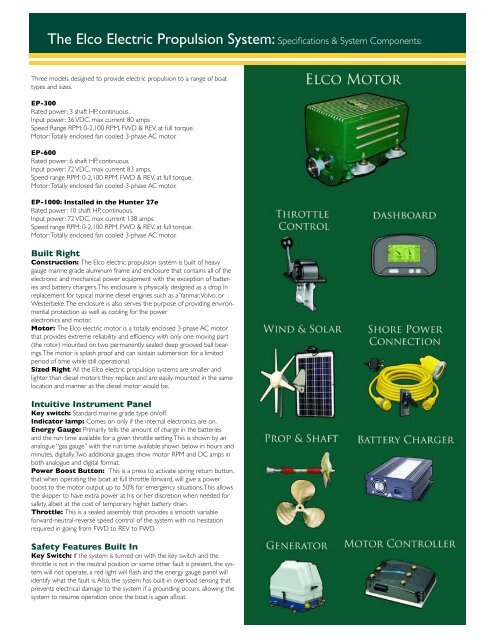Hunter 27e
Hunter 27e
Hunter 27e
You also want an ePaper? Increase the reach of your titles
YUMPU automatically turns print PDFs into web optimized ePapers that Google loves.
The Elco Electric Propulsion System: Specifications & System Components:<br />
Three models designed to provide electric propulsion to a range of boat<br />
types and sizes.<br />
EP-300<br />
Rated power: 3 shaft HP, continuous.<br />
Input power: 36 VDC, max current 80 amps<br />
Speed Range RPM: 0-2,100 RPM, FWD & REV, at full torque.<br />
Motor: Totally enclosed fan cooled 3-phase AC motor.<br />
EP-600<br />
Rated power: 6 shaft HP, continuous.<br />
Input power: 72 VDC, max current 83 amps.<br />
Speed range RPM: 0-2,100 RPM, FWD & REV, at full torque.<br />
Motor: Totally enclosed fan cooled 3-phase AC motor.<br />
EP-1000: Installed in the <strong>Hunter</strong> <strong>27e</strong><br />
Rated power: 10 shaft HP, continuous.<br />
Input power: 72 VDC, max current 138 amps.<br />
Speed range RPM: 0-2,100 RPM, FWD & REV, at full torque.<br />
Motor: Totally enclosed fan cooled 3-phase AC motor.<br />
Built Right<br />
Construction: The Elco electric propulsion system is built of heavy<br />
gauge marine grade aluminum frame and enclosure that contains all of the<br />
electronic and mechanical power equipment with the exception of batteries<br />
and battery chargers. This enclosure is physically designed as a drop in<br />
replacement for typical marine diesel engines such as a Yanmar, Volvo, or<br />
Westerbeke. The enclosure is also serves the purpose of providing environmental<br />
protection as well as cooling for the power<br />
electronics and motor.<br />
Motor: The Elco electric motor is a totally enclosed 3-phase AC motor<br />
that provides extreme reliability and efficiency with only one moving part<br />
(the rotor) mounted on two permanently sealed deep grooved ball bearings.<br />
The motor is splash proof and can sustain submersion for a limited<br />
period of time while still operational.<br />
Sized Right: All the Elco electric propulsion systems are smaller and<br />
lighter than diesel motors they replace and are easily mounted in the same<br />
location and manner as the diesel motor would be.<br />
Intuitive Instrument Panel<br />
Key switch: Standard marine grade type on/off.<br />
Indicator lamp: Comes on only if the internal electronics are on.<br />
Energy Gauge: Primarily tells the amount of charge in the batteries<br />
and the run time available for a given throttle setting. This is shown by an<br />
analogue “gas gauge” with the run time available shown below in hours and<br />
minutes, digitally. Two additional gauges show motor RPM and DC amps in<br />
both analogue and digital format.<br />
Power Boost Button: This is a press to activate spring return button,<br />
that when operating the boat at full throttle forward, will give a power<br />
boost to the motor output up to 50% for emergency situations. This allows<br />
the skipper to have extra power at his or her discretion when needed for<br />
safety, albeit at the cost of temporary higher battery drain.<br />
Throttle: This is a sealed assembly that provides a smooth variable<br />
forward-neutral-reverse speed control of the system with no hesitation<br />
required in going from FWD to REV to FWD.<br />
Safety Features Built In<br />
Key Switch: If the system is turned on with the key switch and the<br />
throttle is not in the neutral position or some other fault is present, the system<br />
will not operate, a red light will flash and the energy gauge panel will<br />
identify what the fault is. Also, the system has built-in overload sensing that<br />
prevents electrical damage to the system if a grounding occurs, allowing the<br />
system to resume operation once the boat is again afloat.

















